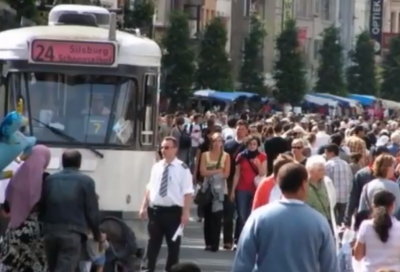![[BLOG] Superdiversity in Antwerp : the Scottish perspec](https://kifkif.be/sites/default/files/styles/large/public/oldsite-data/antwerpen-centre-map-99.jpg?itok=Uy-x5kRG)
While the brief interaction between the old couple was one of negativity, it can also be seen as a paradox of superdiversity.
It was just another groundhog day in our placement, spending some time editing video clips. Usually at 5pm we would grow tired and head off home. Along the way we talked about how our next project on Superdiversity would provide more opportunities to get involved in social work. As the tram home approached, I noticed it was busy - as always some were more in a rush to get on the tram. Amongst this late afternoon rush hour a small push and shove broke out between an old Belgian man and a old Moroccan lady to see who was going to get on first. They both seemed to be old enough to have grandchildren. Clearly one was not happy with the other, but my Dutch is minimal so most of the conversation seemed to go over my head; unfortunately the few words that I did understand were not ones I would have expected.
As the old man enters the tram he throws an insult to the women in Arabic - or I recognised it to be, as it shares some similar vocabulary to my own language of origin. He utters the word “Sharmuta” referring to the woman as a “whore.” Her response in comparison was quiet dignified as she asked if his “mother taught him that”. By the bemused look on my colleagues face I assumed he was oblivious to the harsh exchange, as it was over as quick as it began.
The language used is one you’d expect from antisocial delinquents. However, it struck me that this old man was so enraged that he used a language he had no knowledge of to insult another human being that caused him offence. Is this a showing the many faces of Superdiversity? As individuals from different cultural backgrounds live in close proximity, what shared values or norms emerge? It seems that the only thing that the old man and women shared is an understanding of how to insult others in a different language. What hope can we give to superdiversity and integration working if the older generation only communicates through insults and hostility? How is the younger generation expected to interact without reproducing this kind of behaviour? This encounter has led me to contemplate these questions frequently. My feeling about the incident at the time was that it was during a busy period and it was hot so maybe people were less tolerant or more impatient as a result. However, the encounter has opened more questions then answers. I mean: you don’t really come across that kind of thing every day from the retired older generation back in Scotland.
Reading on superdiversity and living in Antwerp seems to create a contradiction of two different identities of the city. On the one hand you have the high fashion and the artisan, wealthy young middle class who live in the central parts of the city and alongside them live different generations of immigrant descendants who are of lower social class and tend to have a higher proportion of unemployment in comparison. None the less, these two contradictions in wealth seem to live side by side. This contradiction leads me to inquire: is it working? Is there that sense of community and shared neighbourhood values that thrives on its heterogeneous identity or is there segregation and alienation?
What this incident has been able to show me is that the ideas behind superdiversity are clearly evident in Antwerp. The fact is, the old man could have used any other word in his native tongue to convey his displeasure. However, he instead used a foreign language to ensure that he conveyed his disagreement in a manner that would have the biggest impact on the old woman. This seems to suggest to me that the old man has been around a variety of different cultures and perhaps learnt some phrases from a friend or neighbours. Thus showing how superdiverse he is. While the brief interaction between the old couple was one of negativity, it can also be seen as a paradox of superdiversity. On the one hand, it shows how different cultures living in close proximity can develop shared cultures such as the use of languages - however it also shows how the difference can be highlighted during hostile interactions.
Looking back now, over a month since the incident, I can reflect as to the reasons why this incident has stuck in my mind. If I briefly compare it to the UK then this incident would be very rare. Admittedly this may be due to the reserved nature of the ‘British identity’. Meaning that an older person would not react in that manner when there is an altercation. In the UK, it would be more likely that the old man went home and released his anger in the privacy of his own home.
Antwerp seems to lack the capacity to recognise and celebrate its heterogonous identity. As a port city there is an abundance of opportunity for different cultures to interact - however, the policy formation that focuses on the homogenous identity seems to prevent the city’s capacity to celebrate its variety. Focus on homogeneity by the policy makers creates an artificial identity that neglects the large variety of cultural norms and values that collaborate to create Antwerp’s identity. In a way, the policy formation on integration; the altercation between the old couple and the lives of the urban middle class dwellers along with the poorer migrant communities can be compared to the tram lines that criss cross the streets of Antwerp. It ensures that the lived experience of the two groups co-exist side by side, however in places where these two lives cross paths the interaction may become one of hostility and protectionism of self-interests.
>>> Steven Clark and Missale Solomon, two Scottish intern at Kif Kif will blog about the Superdiversity in Antwerp, their host city. Read Steven's first blog here

